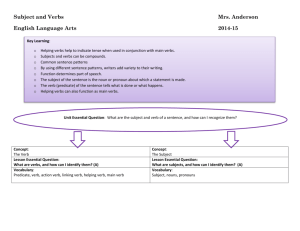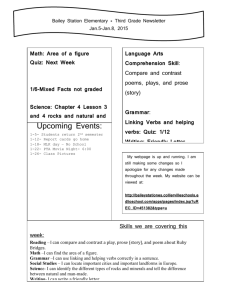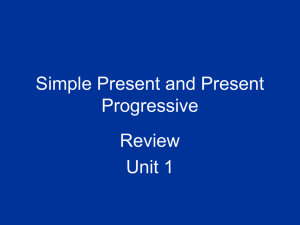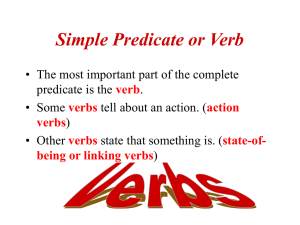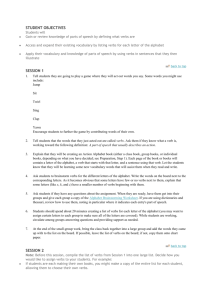ABC Action Verb Lesson Plan
advertisement
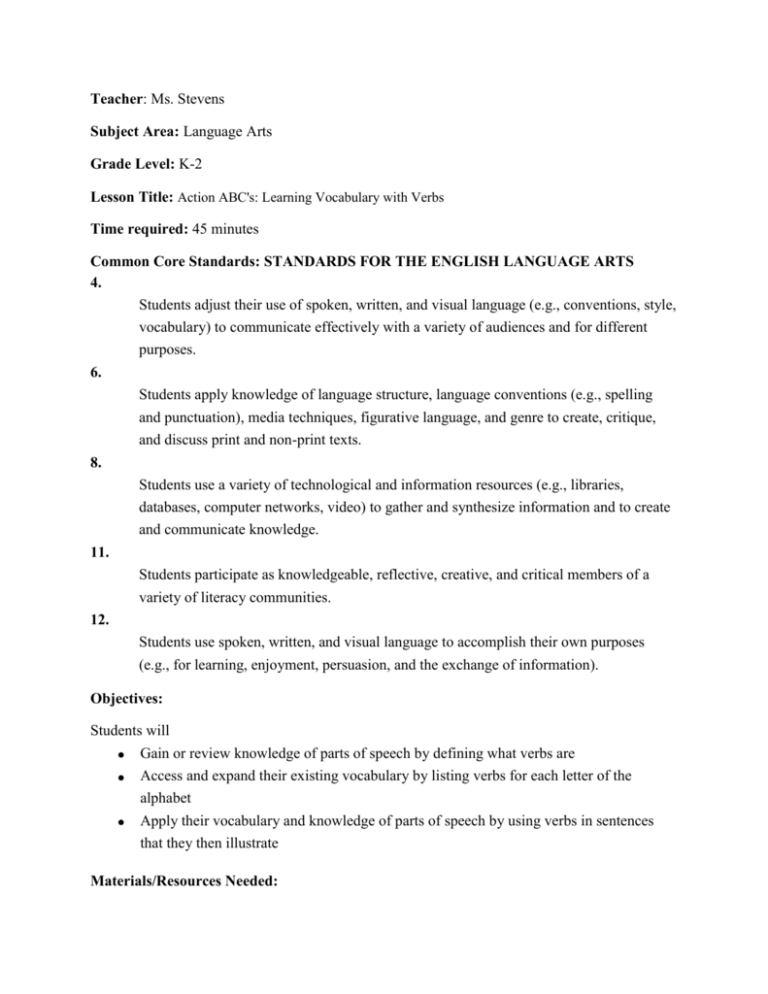
Teacher: Ms. Stevens Subject Area: Language Arts Grade Level: K-2 Lesson Title: Action ABC's: Learning Vocabulary with Verbs Time required: 45 minutes Common Core Standards: STANDARDS FOR THE ENGLISH LANGUAGE ARTS 4. Students adjust their use of spoken, written, and visual language (e.g., conventions, style, vocabulary) to communicate effectively with a variety of audiences and for different purposes. 6. Students apply knowledge of language structure, language conventions (e.g., spelling and punctuation), media techniques, figurative language, and genre to create, critique, and discuss print and non-print texts. 8. Students use a variety of technological and information resources (e.g., libraries, databases, computer networks, video) to gather and synthesize information and to create and communicate knowledge. 11. Students participate as knowledgeable, reflective, creative, and critical members of a variety of literacy communities. 12. Students use spoken, written, and visual language to accomplish their own purposes (e.g., for learning, enjoyment, persuasion, and the exchange of information). Objectives: Students will Gain or review knowledge of parts of speech by defining what verbs are Access and expand their existing vocabulary by listing verbs for each letter of the alphabet Apply their vocabulary and knowledge of parts of speech by using verbs in sentences that they then illustrate Materials/Resources Needed: Computers with Internet access and printing capability Bookmaking materials Dictionaries and thesauri Pencils, markers, and crayons Schedule Session 1: Tell students they are going to play a game where they will act out words you say. Words may include: Jump Sit Twirl Sing Clap Include: Yawn: Encourage students to further the game by contributing words of their own. Input: Tell students that the words that they just acted out are called verbs. Ask them if they know what a verb is, working toward the following definition: A part of speech that usually describes an action. Explain that they will be creating an Action Alphabet book (a class book). Each page of the book or books will contain a letter of the alphabet, a verb that starts with that letter, and a sentence using that verb. Let the students know that they will be learning some new vocabulary words that will assist them when they read and write. Ask students to brainstorm verbs for the different letters of the alphabet. Write the words on the board next to the corresponding letters. As it becomes obvious that some letters have few or no verbs next to them, explain that some letters (like x, k, and z) have a smaller number of verbs beginning with them. Ask students if they have any questions about the assignment While students are working, circulate among groups answering questions and providing support as needed. Procedure: The students will choose a list of verbs that they want to perform The students will find photos from the computers and print them The students will put together their books Model: Illustrate the proper method of the activity by demonstrating it to the class before they engage in the activity. Check for Understanding: Students will be given the Alphabet Brainstorming Worksheet. (20 minutes) Guided Practice: At the end of the small-group work, bring the class back together into a large group and add the words they came up with to the list on the board. Closure: Have students reflect upon the lesson by sharing what they learned. Possible questions to ask include: o What is a verb? o What are four different verbs you know? o What letters were the hardest to find verbs for? o What new words did you learn? o What page that you created did you like the best and why? Independent Practice: Students are given a worksheet on action verbs for homework. Students will also be assigned to create their own mini-verb dictionary (5 words). Instructional Theory: The instructional theory is Social-constructivism. This theory was designed to for the teacher to instruct the students by demonstration. After a demonstration, the student should be able to perform that which the teacher have displayed. Instructional System: The instructional system used is Bloom’s Taxonomy and this system was used because it focuses on all three domains on the students, which are cognitive, affective and psychomotor and it produces a holistic form of education for the students. Bloom’s Taxonomy has learning objectives to help reach the students with their higher order thinking skills. The cognitive domain tells what the students know, the affective domain tells how the student feels, and the psychomotor domain tells what the student can do. Method of Assessment 1. Group Assignment & Rubric – Students demonstrate and recognize all acts of action verbs. Teacher: Ms. L. Stevens ACTION ABC’S: STUDENT ASSESSMENT RUBRIC Student name Overall comprehension Names assigned Writes verb number of verbs sentence(s) (understands assignment; correctly completes book or book pages) (grammatically correct; uses verb correctly) Assessment Key 3 = Exemplary 2 = Sufficient 1 = Insufficient Illustrates verb sentence(s) (appropriate and creative illustration)


